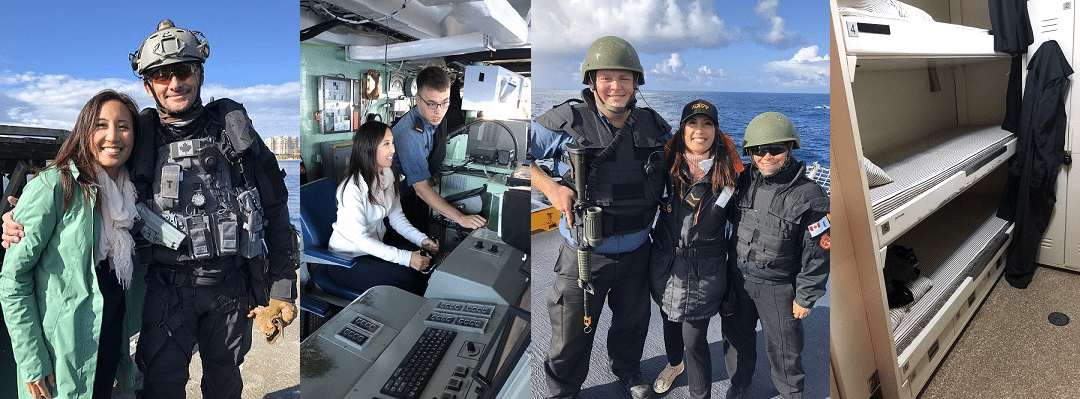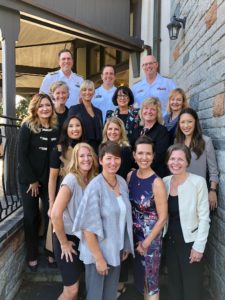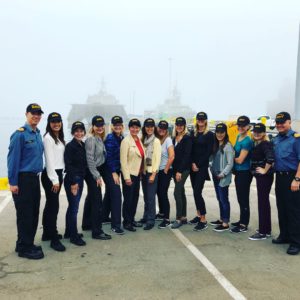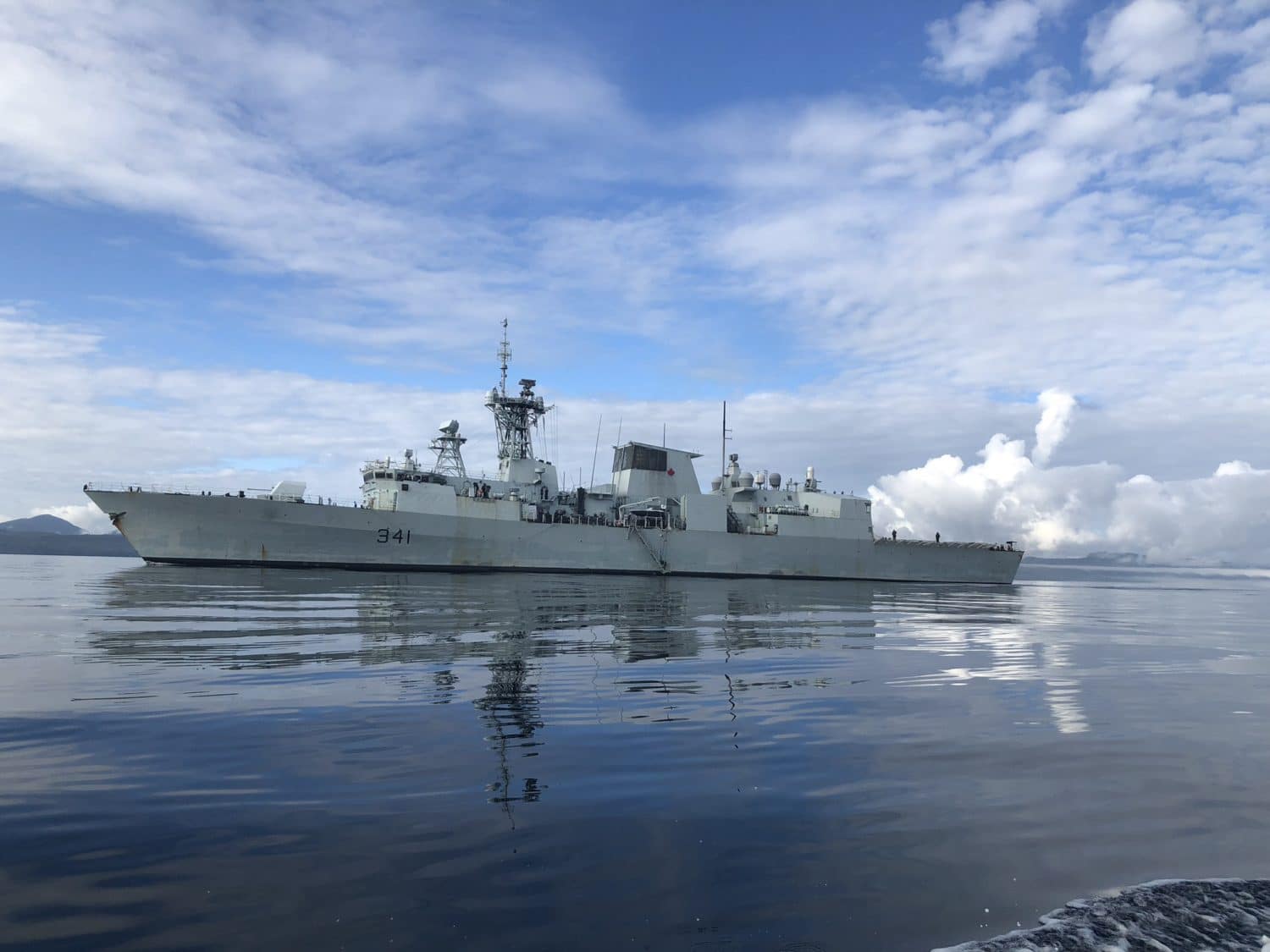Written and as experienced by: Maili Wong
I recently joined the Royal Canadian Navy as part of the Canadian Leaders at Sea (CLaS) program. I spent 4 days aboard a naval ship and it changed my perspective forever!
Picture this: 12 leading Canadian business women are invited to leave their stilettos at home and join the Canadian Navy aboard the HMCS Ottawa warship, stepping outside their comfort zones and into the foreign lifestyle of a military warrior. Some of my highlights included:
- Sleeping in tri-level military bunk beds complete with seatbelts for rough seas
- Surviving the rockiest night at sea, highlighted by 4 meter swells while sailing at 24 knots 100 miles offshore California to Esquimalt, BC
- Participating in military surface firing exercises, Man Overboard exercises and “battle problem” demonstrations
- Be-friending a Naval Tactical Operations Group Leader (i.e. “Navy Seal”) and taking a selfie with him while fully-loaded in military weaponry
- Within 45 minutes of landing after the 4 day open sea adventure, cleaning up and dining at a formal reception at the official Government House in Victoria, with the British Columbia
- Lieutenant-Governor Janet Austin, the senior Canadian Naval leadership and Commander of the Pacific Fleet
Would you believe it? Well, it happened, and I’m grateful to share with you the lessons I learned from this incredible life adventure. Upon reflection, this experience has helped me be a better mom, friend, leader and trusted strategic advisor to my clients, by enriching my perspective after “walking the walk” and after gaining a deeper understanding about how to help others find stability amidst turbulent situations. It has also helped me gain a new perspective on how to build a stronger and more deeply rooted foundation, upon which to build sustainable growth.

Lessons Learned:
1. Purpose – The purpose of this CLaS program is to educate civilian leaders about the important role the Royal Canadian Navy (RCN) plays to ensure free and fair use of the seas. While many of us (me included) may have taken this for granted as we live our daily lives, the fact is that the RCN actively serves to defend the Canadian Coast, and participates in disaster relief and rescue missions globally, using a small number of assets as best and impactfully as possible, so we civilians can “live better lives”. The RCN’s purpose also includes important functions like fighting drug trafficking and overfishing, and as one of 29 nations in NATO, the RCN also fights to protect our allies.
2. People – The RCN is full of incredibly talented, intelligent and compassionate individuals who work together effectively in tense and even dangerous situations.
One example where I saw this in action, was during the “battle problem” exercise. During a routine exercise, a surprise (staged) intervention from a hostile aboard a small watercraft threatened to attack our warship. The crew on the Naval Bridge quickly jumped into action in a sequence of commands and responses between the Captain and his surrounding officers. Their intention was to bring the most accurate and timely information about the hostile’s actions to the Captain, so he could make the best possible decision about his ship’s next defensive steps. Warning shots were ultimately fired, and the hostile backed away. I learned the importance of having a strong and capable team around a wise and decisive leader, to drive strong collective results.
I also learned how the Navy puts people at the heart of their business. While they have state-of-the-art navigation and warfare technology, a robot may never be as creative as a human, and the final decision is always made by the Commanding Officer.
Separately, I also observed a very progressive attitude towards change and equal treatment of women in the Royal Canadian Navy, amongst the people on board. Equal pay amongst women and men of equal rank has been the norm for years. There are also at least two female Commanding Officers in the RCN, the highest ranking position in control of a warship.
3. Planning – The Navy engages in great depth of planning, risk management, and contingency analysis to help mentally and physically prepare for various scenarios at sea. Given the unpredictability of the ocean waves and weather, much like the unpredictability of financial markets, the RCN pre-assigns accountability and actions so that when things go wrong (i.e. boat problem, engine malfunction, fire or stormy seas), each person in the crew knows exactly what they need to do.
The planning also includes escalating levels of action, based on carefully calculated probabilities and scenarios, to help remove the emotion and stay focused on the right actions. This reminded me of how in managing client investment portfolios, in “stormy financial situations” we also use pre-calibrated stop losses or action steps to minimize financial losses and help provide stability for our clients. Planning is one of the five key guideposts in the Smart Risk Investing Roadmap.
4. Perspective – The leadership ranks in the RCN, whom I met, demonstrated an earnest and fresh perspective, a willingness to evolve and continually improve, and a desire to embrace diversity of thought towards a constant state of evolution. We civilians were invited into several roundtables with the senior ranking officers, who were interested in our advice and feedback on how the RCN could improve, and engage more capable Canadians to consider a career with the Navy.
Before “joining” the Navy, my perception of the Navy was that it was a strict (perhaps threatening and controlling) military regiment. Instead, I was surprised to experience a warm, compassionate and friendly group of people who demonstrate loyalty and hard work, and are genuinely proud of the good work they do on behalf of us Canadians.
 5. Positive Action – The Commanding Officer acknowledged that even in the military, in tense, dangerous situations, people may first react with “fight, flight or freeze”. Especially when scared, people often “freeze” and fail to respond in a functional manner. To move beyond these automatic emotional responses, the Royal Canadian Navy trains their officers to shout each command 3 times, (i.e. “fire, fire, fire!” Or “man overboard, man overboard, man overboard!”) to break people free of the “freeze” response and into positive action.
5. Positive Action – The Commanding Officer acknowledged that even in the military, in tense, dangerous situations, people may first react with “fight, flight or freeze”. Especially when scared, people often “freeze” and fail to respond in a functional manner. To move beyond these automatic emotional responses, the Royal Canadian Navy trains their officers to shout each command 3 times, (i.e. “fire, fire, fire!” Or “man overboard, man overboard, man overboard!”) to break people free of the “freeze” response and into positive action.
This reminded me and helped me empathize with clients who may feel scared or confused amidst global financial market turmoil, that they also may experience “fight, flight or freeze”. As my clients’ trusted strategic advisor, much like the Commanding Officer of a naval warship, it is my responsibility to lead them to take positive action beyond their initial emotional response, towards the most beneficial outcome.
Similarly, I’ll admit that stepping onto the HMCS Ottawa warship, I felt a bit nervous and vulnerable. Joining the Navy on a 4-day assignment was completely outside my comfort zone and I literally was stepping off stable land and into the unknown. But I never felt “unsafe”. Even during the stormy seas where I lay strapped into my tiny top level bunk bed below the hull of the swaying ship, the crew aboard the HMCS Ottawa kept us comfortable and safe. As well, the trust the officers and crew placed in us during the military exercises led us to rise to the occasion and perform at a level above even our own expectations.
In summary, I am grateful for the opportunity I have had to experience the strength, compassion and leadership of the Royal Canadian Navy, and I look forward to implementing the lessons learned and new perspective back in my professional practice at home on land.
This experience has helped me become a more trusted strategic advisor to my clients, enriching my perspective after “walking the walk” (thankfully not “walking the plank”) and gaining deeper understanding about how to help others find stability amidst turbulent situations. In this way, I may live in greater alignment with my purpose, which is to help others create a stronger foundation upon which to build sustainable growth, and ultimately achieve exponential impact.
Thank you,
Maili Wong, CFA, CFP, FEA
First Vice President & Portfolio Manager and best-selling Author of “Smart Risk: Invest Like the Wealthy to Achieve a Work-Optional Life”






